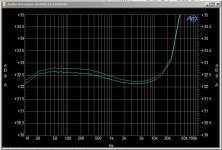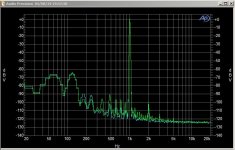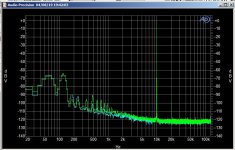So happy to be on your ignore listI notice, by the way, that it is sufficient for me to approach a subject, whatever it may be, for you to find a way to contradict me. It's personal, or just a character trait ?
The subjective one's? Of courseIf the above is correct, then is it possible that most of the discussions here are moot?
Hifi ? Is that you call "hifi" ?
What are you guys arguing about these recordings are all shite?
Last edited:
You demonstrated...nothing.Then you are wrong as before I just demonstrated that it is not (truly) posible to judge an 'original' sound by listening to it's recording,
Ask the other members of its forum involved in music recording if it is not possible "possible to judge an 'original' sound by listening to it's recording".
Last edited:
You demonstrated...nothing.
Ask the other members of its forum involved in music recording if it is not possible "possible to judge an 'original' sound by listening to it's recording".
I thought I am on your ignore list, at the least you told me(the forum) that I am.
So happy to be on your ignore list
This shows how to take his words.I thought I am on your ignore list, at the least you told me(the forum) that I am.
Remarquably ? Listen to the first link i provided:
YouTube
Listen to the bass. it's impressive from those litle boxes, but have-you ever heard an electric bass sounding like this in real life? A halo of extreme low frequencies coming from elsewhere without real body nor presence. A dark shadow.
Listen to the drums. Where is the kick ?
The snare drums sound like a piece of thin paper stretched on a hoop. No barrel.
Listen to the cymbals: "pssss" where we are expecting "klings" or "Kaïïsh". A cymbal is a heavy piece of metal, not a thin cristal glass or thin paper crumpled.
And this female voice, coming from nowhere, with the "t" attacks like saturated and again, a huge halo around. A snake in need of oil ?
My Altec little PC speakers are not shining at all, but the body of the instruments are respected and i ask myself no questions when I listen to them. And they had cost < 150$, not 2000 !
Hifi ? Is that you call "hifi" ?
I have some wonderful Ella Fitzgerald vinyls (from the Norman Grantz Great American Songbook series) and the brass, bass, drums and piano sound wonderful on the LS50's.
Much of the problem with music is in the recording. The early stereo stuff is remarkably natural with great imaging and a weighty sound below about 300 Hz. Must have been the mic placement and the actual mics they used. nowadays everyo0ne relies on plug ins, and while you can artificially create a big sound stage, they don't sound natural.
One of the most disappointing records I got recently was one from Christian MacBride. Big band but absolutely flat.
Talking of fabulous recordings, Benny Goodman at Carnegie Hall on Jasmine and the Bernstein/ Gershwin recording on Sony, Bonsai recommended both arrived today, yippy!!
Ah - hope you like the Gershwin/Bernstein recording - fantastic stuff IMV!
John, I completed the prototype of the thermal feedback fan that we've been talking about from time to time. I imagine it will let you run your super high bias power amp for more than a couple hours at a time. You'll have to pick which fan you'll install, and that means selecting diameter, airflow, RPM, supply voltage, etc. Lots of people gush enthusiastically about the European manufacturer "Noctua", whose fans are extremely quiet.
Here's the design and the performance of the first prototype
Fan inside audio chassis: variable speed, temperature controlled, analog. No PWM.
You'll have to excuse me for selecting a 24V fan in the prototype; that matches the diyAudio Store's "M2x" class A power amp, which I helped with, and a bunch of other First Watt audio projects also in the Store.
_
Here's the design and the performance of the first prototype
Fan inside audio chassis: variable speed, temperature controlled, analog. No PWM.
You'll have to excuse me for selecting a 24V fan in the prototype; that matches the diyAudio Store's "M2x" class A power amp, which I helped with, and a bunch of other First Watt audio projects also in the Store.
_
Last edited:
Yes, they are readable. And here's a review of the setup.
Thanks for posting the link to the review. I could have just gone into google and searched for Stirling Trayle and found his website which has numerous reviews, etc, along with what he does. I also was able to read what John posted from his audio society notes.
I now have a much better idea of what goes on with this method of setting speakers. It's all based on using music and listening for specific cues for specific aspects of the setup. What I do is a lot simpler, but still is based on listening for specific audio cues, which can be hard to hear and can try one's patience.
This is certainly lots different from what most people do, set the speakers whereever and just toe them straight at you and sit at the triangle point. It takes very little time and sounds good. And if you move away from the triangle point the music does not sound as good, so therefore that is the best place. I used to do this too.
Sure, just like the photo reproduction of a painting for others to see, it would be considered a high degree of fidelity if the reproduction resembles what the artist painted to a high degree.
Side by side painting/photo image comparisons should easy, but how can you compare recorded music with unprocessed live music?
Hi T, thanks for posting link to that audition of your Kef's and other speakers.You demonstrated...nothing.
Ask the other members of its forum involved in music recording if it is not possible "possible to judge an 'original' sound by listening to it's recording".
The microphone used is well good enough and the recordings of a range of speakers are detailed enough to get a very good idea of the 'character' of each of them, indeed there is a video of comparison of a bunch of interconnect cables where the differences are clearly apparent, at least to my ears.
The demonstration of the 'free RCA' cable sounds in that system as do such cables in my system, I found both the Audioquest cables awful, the Blue Jeans cable I could live with.
I agree the Kefs are hopeless in the midrange and their portrayal is like a watercolour painting with no depth, no clarity and no contrast in the all important midrange, excessive 'impression' of bass and 'brittle' highs.
I would also add that they sound inefficient and overly damped such that they have no 'life' in their sound, a criticism I would also level at the much admired LS3/5A.
Both these speakers are fine with simple/sinewave type music but fail miserabley with asymmetrical waveforms such as percussion and voice.
My housemate has a 'respectable' LG system consisting of LG top of the line floorstanders and LG AV/surround class D amplifier in the front room.
This system gives the same result as the Kefs with hopeless articulation in the mids causing need to 'turn it up' to be able to understand dialogue.
On first listen this setup is clean, clear, powerful but it lacks definition, punch, depth and sense of realism in the mids....to me this system is unlistenable in the long term especially when compared to my system.
Decorum dictates that I have never criticised his once 'cherished' system, and noteworthy is that he never bothers to use this system for music and goes straight to hijacking my system with his choices of stored or streaming music....win/win he digs the sound of my setup and I get to hear music that I otherwise might not.
I am pretty certain that this is at least partly caused by ferrite cored output inductors, and in my experiments with my formulation on other class D amplifiers I have been able to remedy this character and render such amplifiers to deliver way better clarity and articulation, and then class D can sound good, really good, but still 'mechanical'.
Adding a central active sub will serve to put some sense of power and foundation to the system but will not cure the mids and likely serve to exaggerate the mids/vocals failings of these 'famous' speakers.
These modern 'lifestyle' speakers look great/unusual in the right setting but as for enjoyable listening...yeah/nah.
Dan.
Last edited:
Levinson JC-2
Phono stage alone, gain 32dB, deviation from RIAA, 75us is in feedback network, thus increase in output level above 20kHz
FFT 1kHz, 25mVrms input, 1Vrms output, 2nd -102dB, 3rd -114dB
FFT 10kHz, 125mVrms input, 1Vrms output, 2nd -100dB, 3rd -110dB, not bad
Thank you for combining my previous measurements in one post
My problem with the Levinson JC-2 is not really the line stage. It would up being in the Phono stage (active EQ)
Phono stage alone, gain 32dB, deviation from RIAA, 75us is in feedback network, thus increase in output level above 20kHz
FFT 1kHz, 25mVrms input, 1Vrms output, 2nd -102dB, 3rd -114dB
FFT 10kHz, 125mVrms input, 1Vrms output, 2nd -100dB, 3rd -110dB, not bad
Thank you for combining my previous measurements in one post
Attachments
Try listening to the comparison of interconnect cables and report back what you find...this might be illuminating as to the definition and clarity of your system and/or your ears.Not sure what you are supposed to learn from a random you tube video recording of the speakers - with a total lack of info as to the process. About as pointless as it gets.
Dan.
and I get to hear music that I otherwise might not.
That's easy just ask.
- Status
- Not open for further replies.
- Home
- Member Areas
- The Lounge
- John Curl's Blowtorch preamplifier part III


